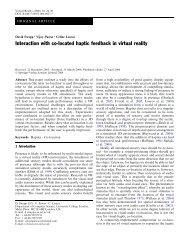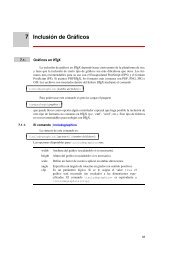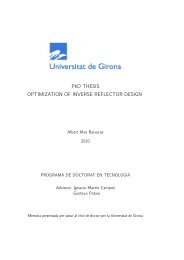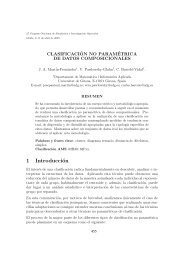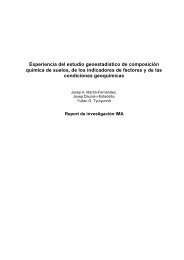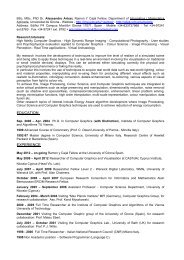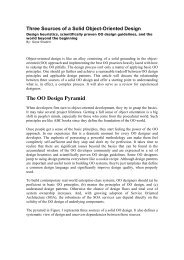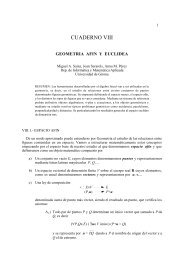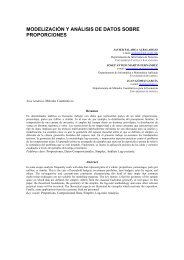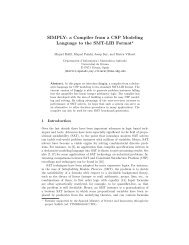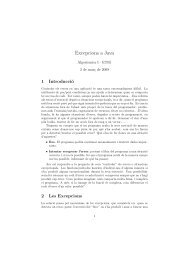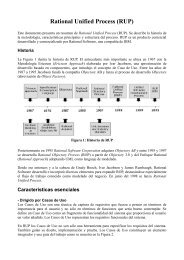Thomas, C.W. and Aitchison, J.
Thomas, C.W. and Aitchison, J.
Thomas, C.W. and Aitchison, J.
Create successful ePaper yourself
Turn your PDF publications into a flip-book with our unique Google optimized e-Paper software.
70.0675 0.0622 0.0788 0.0724 0.1254 0.1102 0.0560 0.0701 0.1460 0.0991 0.11230.0993 0.1111 0.1080 0.1028 0.0709 0.0807 0.0389 0.1190 0.0815 0.1076 0.08030.0674 0.0810 0.0899 0.0765 0.0422 0.1190 0.1011 0.0845 0.0899 0.1354 0.1132with successive degrees of approximation 0.46, 0.69, 0.84, 0.92.We note that in the first approximation the major relative increase is in Ca <strong>and</strong> to alesser extent Si. At the second approximation, both Mg <strong>and</strong> Ca show a relativeincrease <strong>and</strong> the increase in Mn seen earlier is also evident. At the thirdapproximation the main feature seems to be some relative depletion of Na, to arelative gain in K? And so on in a tentative interpretation.There are substantial statistical deficiencies in this area of compositional dataanalysis. For example at the various stages of approximation the near equality of asubset of components suggests that the corresponding subcomposition is stable forthat stage. But can we devise suitable statistical tests of such a subcompositionalstability hypothesis, Also although the singular value decomposition is identifyingorthogonal aspects of the process it may be that some other representation, say of thefirst two stages may provide a more enlightening view of the process. This would be arestructuring rather similar to the varimax technique in principal component analysis,but how should it be done compositionally? Again, suppose that the geologist suggestthat there may be two basic processes at work, possibly independently, a carbonate<strong>and</strong> a siliciclastic process. A possible method of modelling might then be to setx = $ ( u π ⊗ β ) ⊕ ( u π ⊗ β ) ⊕ p,n n1 1 1 n2 2 2where β1, β2are D-part compositions somehow representing carbonate <strong>and</strong>siliciclastic subcompositions, but how, π1, π2are parameters representing the extentof the carbonate <strong>and</strong> siliciclastic importance <strong>and</strong> requiring estimation, the ucoordinates again requiring to be determined <strong>and</strong> the p a composition, rather like theerror term in a regression analysis. It is obvious that there is much statistical researchremaining to be done in this important area of compositional data analysis. We arecurrently working in this area <strong>and</strong> will certainly report any new work atCODAWORK03.REFERENCES<strong>Aitchison</strong>, J., 1986, The Statistical Analysis of Compositional Data: Chapman <strong>and</strong>Hall, London. Reprinted in 2003 with additional material by The Blackburn Press.<strong>Aitchison</strong>, J., 1990, Relative variation diagrams for describing patterns of variabilityof compositional data: Math. Geology, v. 22, p. 487-512.<strong>Aitchison</strong>, J., 1997, The one-hour course in compositional data analysis orcompositional data analysis is easy, in Pawlowsky Glahn, V., ed., Proceedings of theThird Annual Conference of the International Association for Mathematical Geology:CIMNE, Barcelona, p. 3-35.



